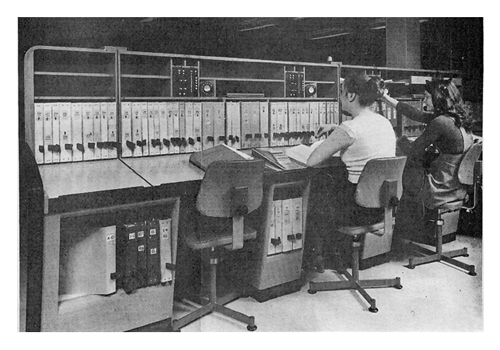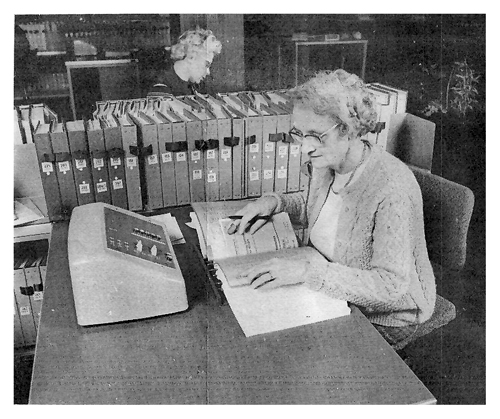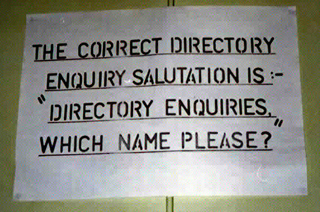 |
Prior to 1945, Directory Enquiry (DQ) calls were answered on a standard enquiry (EQ) position complete with jackfields and a keyshelf, with only a limited amount of room for directories and loose-leaf binders. |
A brief history...
Directory Enquiries were originally answered at an ordinary 'enquiry position' on a standard suite of switchboards. It was not until later years that specially designed boards were produced for directory work. Normal paper copy directories were first supplied and later on, 'flexo' copy pages which fitted into binders and could be printed at regular intervals to keep pace with the changes for removing and new subscribers. With ever more customers, the amount of space to house all of the necessary directories was becoming a burden and made physically heavy work for the operator who had to locate the correct book from a growing number of volumes. Microfiche film entries accessed on special viewers was an interim solution to the problem, but still the amount of data was increasing. Finally, a computer database under the Directory Assistance Service (DAS) was the answer. Still later, Automatic Voice Response (AVR) recordings have saved the operator from continually saying, 'The number you require...'.Southampton (DQ) Suite
 |
It was not practical to have a full keyshelf with the maximum number of cord circuits, simply to take incoming directory enquiries. A prototype of a new suite of positions especially designed for DQ work was first trialled in both Bradford and Cardiff. The final design, was installed at Southampton exchange in 1953. Thus the Southampton Suite of positions was born. |
The Southampton type suite was provided up to 1972 when the Office Type positions were introduced:-
Office Type (DQ) Positions
 |
Lightweight metal desks for the Office Type DQ layout were made by Roneo. |
Salutations
Which Town?
With paper and microfiche based DQ records, the entries were grouped into a geographical area, serving several towns, so the operator would ask "Directory Enquiries, which town please?" in order to locate the relevant directory or fiche folder. The surname or business name would then be found within that group.
Which Name?
Later still, once the computer based DAS (Directory Assistance Service) came on line, records were ordered by name and then by address, if there was more than a single entry for the surname (e.g. Smith). Thus the salutation changed to "Directory Enquiries-which name please?" After so many years of using the old procedure, some operators needed a reminder to use the new phrase, as the poster opposite illustrates.
 |
...the salutation changed to "Directory Enquiries-which name please?" |
USEFUL FACTS AND FIGURES ABOUT BT DIRECTORIES (July 2003)
Source: BT Group Media Agency News Releases 2003
BT Directories handles 450M calls every year - or 1.25M every day, making it the largest Directory Enquiries provider in Europe and the fourth largest in the world. The average BT customer rings directory enquiries 12 times a year BT Directories employs 3100 people in 26 UK centres, handling approximately 70 per cent of all directory enquiry calls Current services provided include retail and wholesale (for other fixed-line and mobile licensed operators) directory enquiries, 184 UK phone directories, phonedisc services and internet directory enquiries at bt.com BT Directories also employs 1300 people in 10 UK centres dealing with 100 operator services enquiries for BT, Ntl, Colt and others as well as 999 calls for BT and most other operators. This service for 100 operator calls deals with 100m enquiries every year.
All logos and trade marks are the property of their respective owners and are used on the Light Straw site(s) for review only. Students and researchers are recommended to make their own independent enquiries as to the accuracy of the information contained therein.